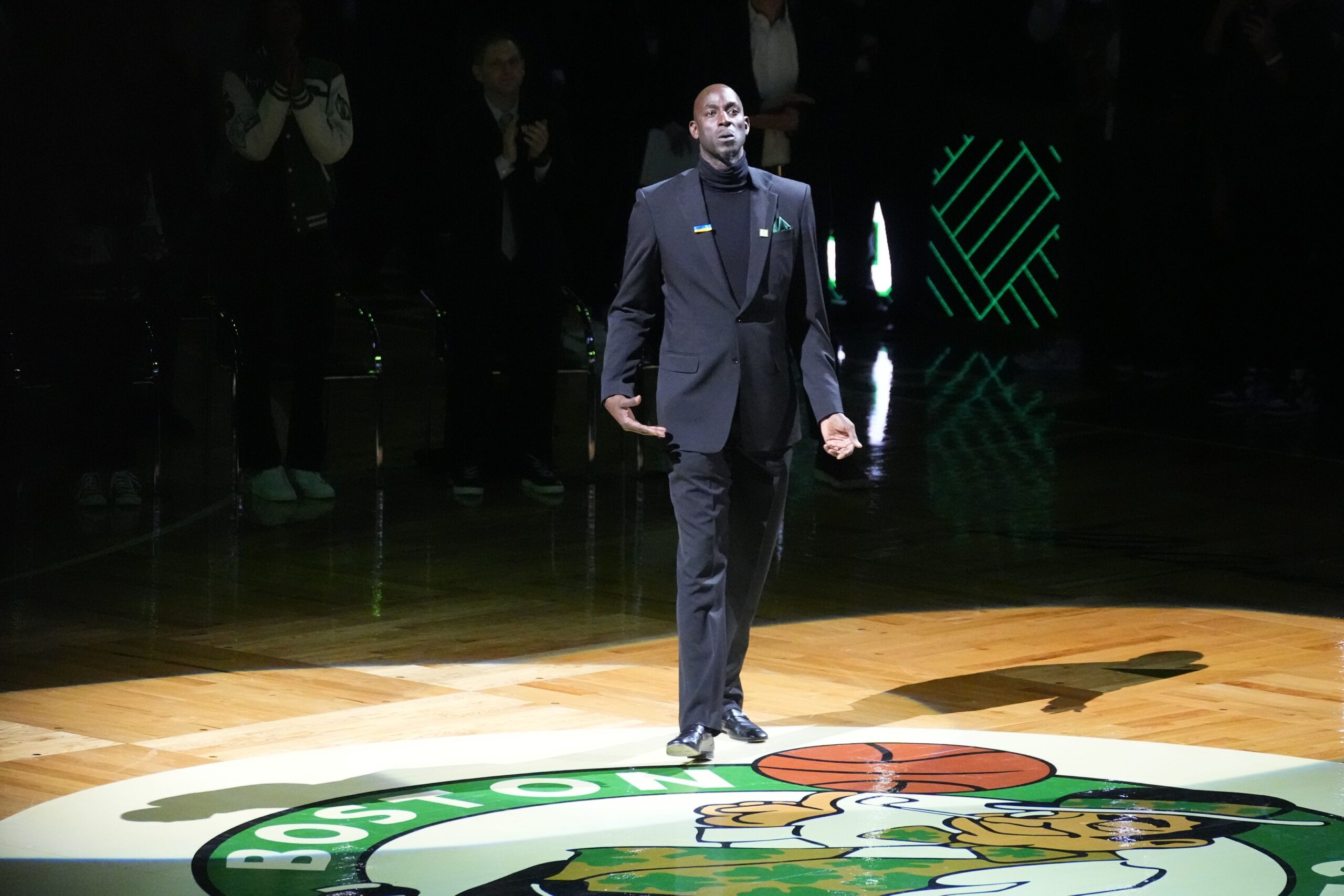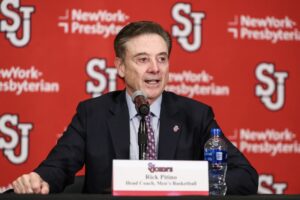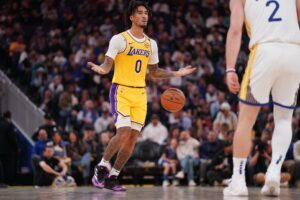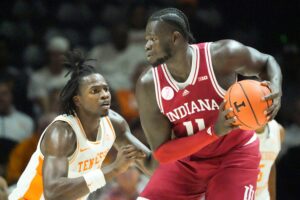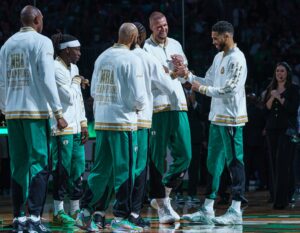After months of trade rumors, the Boston Celtics made a deal for All-NBA forward Kevin Garnett from the Minnesota Timberwolves in 2007. Many teams were interested in Garnett’s services. However, the Celtics ultimately were the team to land “the Big Ticket.”
At the time of the trade, Garnett was still one of the top big men in the league after over a decade with the Timberwolves. In the 2006-07 season, Garnett averaged 22.4 points and 12.8 rebounds per game.
The Celtics acquired Garnett to form a new “Big Three” in Boston next to Paul Pierce and Ray Allen. Championship expectations immediately became prominent for this Celtics team, who had not won the title since 1986. This trade marked the beginning of a new era in Celtics basketball—one with the makings of a new dynasty.
How did this trade hold up for the parties involved? And what happened to the players the Celtics traded to acquire Garnett?
Boston Celtics Trade Throwback #8: Timberwolves’ Kevin Garnett
Full Trade Details
Boston Celtics receive: Kevin Garnett
Minnesota Timberwolves receive: Ryan Gomes, Gerald Green, Al Jefferson, Theo Ratliff, Sebastian Telfair, and two 2009 first-round picks (later became Wayne Ellington and Jonny Flynn, respectively)
Why Did the Celtics Trade for Kevin Garnett from the Timberwolves?
The Celtics had missed the playoffs the last two years and finished the 2006-07 season with the second-worst record in the league. At the time, Pierce was about 30 years old, and he had been with the Celtics since the team drafted him in 1998. With the team finishing with such a bad record, the Celtics were hopeful to land a top-two pick in the 2007 NBA Draft. The thought of pairing Pierce with someone like Greg Oden or Kevin Durant was enticing. As luck would have it, however, the Celtics ended up with the fifth pick of the draft.
Celtics GM Danny Ainge had been eyeing Garnett for a while. Plus, with Garnett and the Timberwolves looking to part ways due to the lack of team success around the big man, this was a good opportunity for Ainge to make his dreams come true.
Originally, Garnett was not interested in playing in Boston and was unlikely to sign an extension with the Celtics (Garnett had a player option after the 2007-08 season). In fact, Garnett originally wanted to team up with Kobe Bryant and play for the Los Angeles Lakers. Ultimately, the Celtics used the fifth pick they got from the draft lottery in a package to acquire Allen from the Seattle Supersonics. Once this happened, Garnett warmed up to the idea of a trade to Boston to play for the Celtics. Ainge got back in touch with former teammate and Timberwolves GM Kevin McHale, and the rest is history.
Why Did the Minnesota Timberwolves Trade Kevin Garnett?
The Timberwolves made it to the Western Conference Finals in 2004 and were led by Garnett, the MVP of that year. Three years later, the team had yet to return to the playoffs, despite Garnett still being one of the league’s best players.
Minnesota had two consecutive seasons with a losing record. It was clear the team was headed towards a rebuild, if they were not already there. Keeping Garnett around did not make sense for either side.
The team also fired head coach Dwane Casey after 40 games during the 2006-07 season in favor of assistant coach Randy Wittman. Trading Garnett to officially begin their rebuild was an obvious move.
There were many teams vying for Garnett, and the Timberwolves were looking to deal Garnett to a team of his choice. That team happened to become the Boston Celtics.
Aftermath of the Celtics Trade for Kevin Garnett from the Timberwolves
Boston Celtics
Immediately after the trade, the Boston Celtics ended the 2007-08 regular season with a 66-16 record after finishing 24-58 the season prior. This 42-win turnaround is still the greatest such turnaround in league history.
Finishing the season with the best record in the league, the Celtics went on to win their 17th championship in history after a six-game series win against the Lakers.
Pierce was named Finals MVP, and the “Big Three” all won their first championship together in Boston.
The Celtics ended the 2008-09 season with a 62-20 record. However, a midseason injury would cause Garnett to miss the last two months of the year. This led to the team losing to the Orlando Magic in seven games in the Eastern Conference Semifinals. Boston returned to the NBA Finals in 2010 before losing to the Lakers in seven games. The Celtics did not return to the NBA Finals for the rest of the “Big Three” era.
Kevin Garnett
In his first season with the Celtics, Garnett averaged 18.8 points, 9.2 rebounds, and 1.3 blocks per game. And on top of helping the Celtics win the title in 2008, Garnett was the Defensive Player of the Year that season. Garnett was also named to the All-NBA First team in 2008.
This defense was no joke 😳🔒 pic.twitter.com/TRxZbJ1HO9
— NBA on ESPN (@ESPNNBA) August 10, 2023
Throughout the 2008 playoffs, Garnett averaged 20.4 points, 10.5 rebounds, and 3.3 assists per game in 26 games.
Over the course of his six-year Celtics career, Garnett averaged 15.7 points, 8.3 rebounds, and one block per game and was selected to four NBA All-Star teams. Garnett was also named to three All-Defensive First Teams and one All-Defensive Second Team during his time in Boston.
Due to his aggressive style of play and outgoing on-court personality, Garnett became a fan favorite in Boston among Celtics fans after the trade. However, the Celtics traded Garnett, along with Pierce, to the Brooklyn Nets in 2013 to begin their rebuild. Garnett finished his career back with Minnesota after the 2015-16 season, and on March 14, 2022, the Celtics retired Garnett’s #5 jersey.
Minnesota Timberwolves
The Timberwolves finished the 2007-08 season with a 22-60 record. After initially getting the third pick in the 2008 NBA Draft, the Timberwolves traded this pick (which eventually became O.J. Mayo) to the Memphis Grizzlies. For this, the Timberwolves got their next star in UCLA’s Kevin Love, just one year after the team made the trade that sent Garnett to the Boston Celtics.
After a 4-15 start to the 2008-09 season, the Timberwolves fired Wittman. McHale stepped down as GM and took over the head coaching role. The team finished the season with a 24-58 record and fired McHale at the end of the season. Minnesota did not make another appearance in the postseason until the 2017-18 season. This 13-season playoff drought is the third-longest in NBA history.
Al Jefferson
In his first year after the trade from the Boston Celtics, Jefferson averaged 21 points, 11.1 rebounds, and 1.5 blocks per game. Jefferson was the team’s leading scorer for the 2007-08 season. The big man had an impressive 2008-09 season as well before tearing his ACL in a February 2009 game against the then New Orleans Hornets.
In 50 games played during this season, Jefferson was once again the team’s leading scorer, averaging 23.1 points per game. The Mississippi native also averaged 9.3 rebounds and 1.3 blocks per game. Jefferson recovered before the beginning of the 2009-10 season and was the team’s leading scorer for the third straight year. However, Jefferson’s scoring input dropped to 17.1 points per game.
The Timberwolves traded Jefferson to the Utah Jazz in July 2010. Jefferson would also play for the Charlotte Bobcats/Hornets and Indiana Pacers before retiring in March 2019.
Gerald Green
The high-flyer only played in 29 games for the Timberwolves before the team traded him to the Houston Rockets in February 2008. In these games with the Timberwolves, Green averaged 5.1 points and 2.1 rebounds over 12.3 minutes per game.
Green ended up having a solid career as a role player. The Texas alum played for the Dallas Mavericks, New Jersey Nets, Pacers, Phoenix Suns, and Miami Heat before returning to the Celtics in 2016. Green also had a second stint with the Houston Rockets from 2017-2019 before officially retiring in 2021.
Sebastian Telfair
Telfair only played with the Timberwolves for two seasons before the team traded him to the Los Angeles Clippers. Over those two seasons, Telfair averaged 9.6 points, 1.9 rebounds, and 5.2 assists per game. Telfair also had a quick stint with the Cleveland Cavaliers before getting traded back to Minnesota.
His second stint with the Timberwolves was not memorable either as he only played in 37 games and started eight of them. The point guard had short stints with the Suns and the Toronto Raptors before playing his final NBA games with the Oklahoma City Thunder during the 2014-15 season.
Ryan Gomes
Of all the players directly going to Minnesota in this trade, Gomes spent the most time with the Timberwolves. In three full seasons with the team, Gomes averaged 12.3 points, 5.1 rebounds, and 1.7 assists per game. Gomes was also a primary starter for his entire stint with the Timberwolves.
The Timberwolves traded Gomes to the Portland Trail Blazers in 2010. However, Gomes never suited up for the team.
After stops with the Clippers and Thunder, the Boston Celtics re-acquired Gomes in a three-way trade. However, the Celtics waived Gomes immediately, and the forward was out of the league afterwards.
Theo Ratliff
Ratliff only played in 10 games for the Timberwolves before the team waived him in February 2008. The 2001 All-Star had short stints with the Detroit Pistons, Philadelphia 76ers, San Antonio Spurs, Bobcats, and Lakers before retiring in December 2011.
Wayne Ellington
The Timberwolves drafted Ellington with the 28th pick of the 2009 NBA Draft. Ellington had a solid career for 13 seasons playing for many teams but was nothing special. In three seasons with Minnesota, Ellington averaged 6.5 points per game.
In 2023, Ellington became a player development coach for the Heat.
Jonny Flynn
The Timberwolves acquired their own first-round pick back in the Garnett trade and selected Flynn with the sixth pick of the 2009 NBA Draft.
Flynn had a solid rookie year and started all 81 games he played for the team, averaging 13.5 points per game. However, after suffering a hip injury, Flynn was not the same player after and became a role player.
The point guard had short stints with the Rockets and Trail Blazers before leaving the league in 2012.
Last Word on the Celtics Making the Trade for Kevin Garnett with the Timberwolves
It is true the Boston Celtics gave up a lot of assets. Even so, it is pretty clear they won this trade. The Celtics likely would have still been at least a playoff team with the addition of Allen, but adding Garnett moved them to championship territory. It is fair to say the Celtics may have underachieved with their “Big Three” with one championship. However, that 2008 title does not happen if Garnett ends up elsewhere.
As for the Timberwolves, it was obvious they had to move on from Garnett. Whether they got the best possible return for him can be debated, however. Though Jefferson was a solid big man with the Timberwolves, he was not the franchise cornerstone he could have been. Granted, much of that was due to his injury. The other players the Timberwolves got in return made a small impact with the team. This includes the two players they drafted with the first-round picks they got out of the deal.
Today, Garnett is considered one of the greatest Celtics players in franchise history and was crucial to the team’s success for six seasons. In hindsight, the Boston Celtics likely make this trade every single time and do not need to think twice about it.


